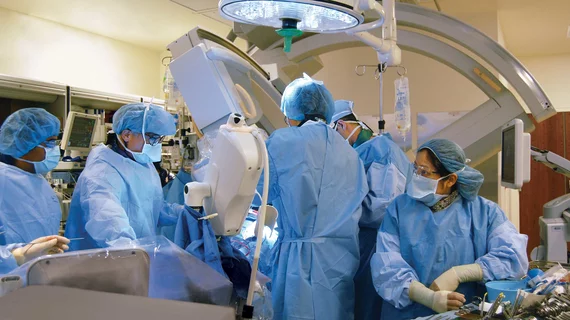Heart damage after TAVR: Follow-up imaging helps cardiologists anticipate problems
Cardiologists can gain valuable insights by evaluating patients for residual cardiac damage within 30 days of transcatheter aortic valve replacement (TAVR), according to a new analysis published in EuroIntervention.[1]
The study’s authors explained that cardiac damage is a term used to represent the full impact aortic stenosis (AS) has had on a patient’s heart. Any assessments of cardiac damage cover the left ventricle, left atrium, mitral valve and tricuspid valve—and almost all studies of cardiac damage have focused on before TAVR instead of after TAVR.
“Up to now, too little attention has been paid to the evolution of cardiac damage after TAVR, not to mention its association with long-term prognosis in TAVR recipients,” wrote first author Yaoyao Zhou, MD, with the Zhejiang University School of Medicine in China, and colleagues. “Therefore, this study sought to investigate the short-term evolution of cardiac damage after TAVR and the association of residual cardiac damage with long-term outcomes.”
Zhou et al. examined data from 785 consecutive adult TAVR patients who underwent treatment at the same facility from March 2013 to March 2020. Exclusions were made due to the presence of previously implanted valves, pure aortic regurgitation or incomplete data. The final cohort included 644 patients with a mean age of nearly 76 years old.
Comprehensive transthoracic echocardiograms, reviewed by a team of cardiologists, were evaluated to track cardiac damage over time. Patients were then divided into five categories based on measurements of cardiac damage at baseline, with the lower stages representing less cardiac damage. Those categories included:
- Stage 0 (2.8%)
- Stage 1 (11.5%)
- Stage 2 (66.3%)
- Stage 3 (11.2%)
- Stage 4 (8.2%)
Older patients and patients with more severe symptoms were more likely to present with advanced stages of cardiac damage. Patients with more advanced stages of cardiac damage also tended to have a lower left ventricular ejection fraction, higher pulmonary artery systolic pressure and higher rates of significant mitral and/or tricuspid regurgitation.
Patients were then categorized into three groups: Stage 0-1, Stage 2 and Stage 3-4. At baseline, patients in the Stage 3-4 groups were more likely to suffer from New York Heart Association (NYHA) Functional Class IV symptoms.
Within 30 days following TAVR, the authors noted, “all groups obtained symptomatic relief regarding their NYHA Functional Class.” Also, left ventricular ejection fraction “improved significantly” among patients in the Stage 2 and Stage 3-4 groups.
How cardiac damage evolved after TAVR
The researchers emphasized TAVR’s impact on patient health after 30 days.
“The influence of the TAVR procedure on the cardiac function of AS patients cannot be underestimated, even in the short term,” the authors wrote. “The cardiac damage stage changed in 22.2% of TAVR recipients within 30 days post-TAVR. As many as 19.9% of TAVR recipients obtained benefits in a reversal of cardiac damage. Specifically, the number of patients in the Stage 0-1 group increased from 92 to 157, while the proportion of the Stage 3-4 group declined from 19.4% at baseline to 10.5% within 30 days post-TAVR.”
The group also examined one-year outcomes, comparing echocardiograms at baseline and after one full year to track how damage evolved during that time.
“The extent of cardiac damage generally improved over time post-TAVR,” the group wrote. “In general, most of the reversal of cardiac damage occurred within the first month post-TAVR.”
Continued cardiac deterioration was seen in certain patients following TAVR. A history of chronic obstructive pulmonary disease and perioperative myocardial infarctions were both independently associated with continued damage within 30 days of undergoing TAVR.
Cardiac damage after TAVR and all-cause mortality rates
Another key takeaway from the analysis was that all-cause mortality after two years gradually became more likely with advanced stages of baseline cardiac damage.
Also, continued cardiac deterioration within 30 days of TAVR was independently linked to a higher risk of all-cause mortality after two years.
“Our study has important implications. it is necessary to reassess residual cardiac damage within short periods after TAVR,” the authors concluded. “It can be leveraged to gain long-term benefits for better risk stratification and prognostication in AS patients undergoing TAVR.”
Click here to read the full study in EuroIntervention, the official journal of EuroPCR and the European Association of Percutaneous Cardiovascular Interventions.

